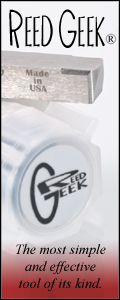Embouchure
The word “embouchure” is a French word that translates to “opening into.” Players of woodwind and brass instruments use this word to describe the formation of the lips, oral cavity, the tongue, jaw structure, and muscles surrounding the mouth used in the production of tone on their respective instruments. The first, and most obvious, function of the embouchure is to keep air from leaking out of the mouth while playing. The second is to provide enough pressure on the reed, from the lips, to put the note in tune and keep it in tune. The role of the lips is that of a cushion for the vibrations of the reed. It must be sensitive enough to make the very slightest adjustments for pitch, volume and tone.
While setting up for a gig, I was admiring our piano players new, expensive synthesizer. I was struck with all the different sounds, and the ability to alter them in seemingly endless variations. Well, he looked at me with my tenor in my hands and said ” Yeh, man, it’s a cool machine, but you have the ultimate “knob”, making a pointing gesture to his lips.
The embouchure is the single thing that makes the Saxophone so expressive and posses such a human, voice like quality. Using the subtle nuances of the embouchure, the vast tonal palette of the Saxophone can stretch from whisper quiet to raucous honking and all shades in between. From classical chamber music to the plaintive wail of Coltrane in his later years.
O.K. Ready? Here we go. This is how it should be done, each and every time. While placing your two front teeth on the top of the mouthpiece, about a half an inch back from the tip, close your lower lip as you normally would. You should rest most of the weight of your head on the mouthpiece. The reason you want to do this is to anchor the mouthpiece in your embouchure so that it is in the same position at all times. If the mouthpiece is in the same place at all times, then the air stream will be directed in the same direction and angle at all times. Make sure that the mouthpiece is entering your mouth straight on. You may want to look in a mirror to check this out. Actually getting in front of a mirror and checking things out is a good thing to do on a regular basis.
Your lower lip should be covering the lower teeth but not pushed all the way in your mouth, nor protruding out. Don’t let your bottom teeth come in contact with the reed unless you want all the dogs in the neighborhood to start howling! Drop your lower jaw slightly, smile with the corners of your mouth just a little. Your throat should be open and relaxed as in the beginning phase of a yawn. At this point, you may feel your ears pop. That’s a good thing. Try to line up the lower teeth with the upper teeth. You may have to compensate for any over bite or under bite that may be present. Although the muscles of the lower lip must do most of the support work, do not ignore the upper lip. Think of the muscles surrounding both the upper and lower lips as a drawstring purse when you pull the strings to close it. Equal pressure from all sides. Try not to apply pressure with your lower jaw. This is known as biting, and basically what you’re doing is stifling the vibration of the reed. One of the main principles in tone production is to get the reed to vibrate as much as possible. Any excess pressure from the jaw is counter productive to a good tone. You should always breathe through your mouth, keeping your top teeth on the mouthpiece. Drop your lower jaw and open your mouth and inhale quickly. By breathing this way, you can get a full breath of air in a very short period of time.
The development of a fine embouchure is a lengthy, if not lifetime, pursuit. You may (should) experience a sore face for the first few months of practicing but this should be resolved with the strengthening and building up of the facial muscles. When this soreness occurs, take a short break, stretch your facial muscles and return to practicing in a few minutes.




